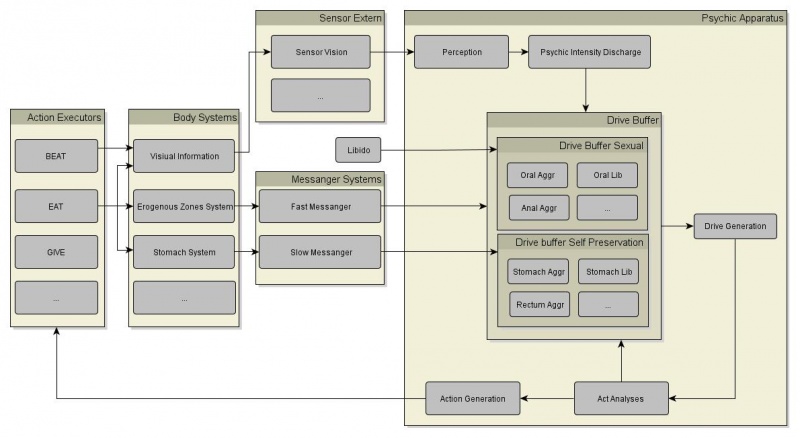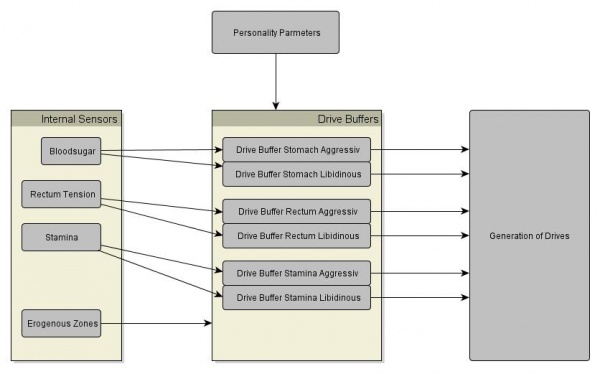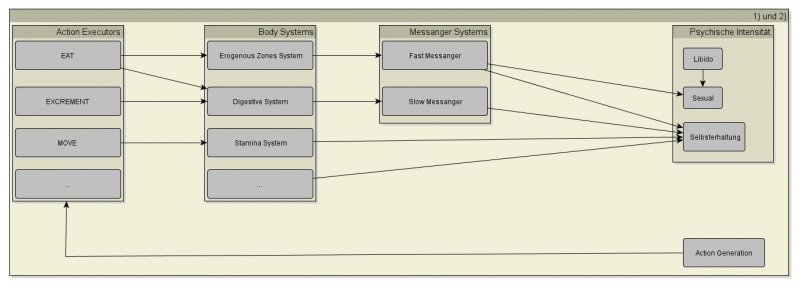Difference between revisions of "Drives"
(→Satisfaction complex drives for non atomic ations) |
|||
| (12 intermediate revisions by 2 users not shown) | |||
| Line 1: | Line 1: | ||
| − | + | ||
| + | == Overview == | ||
| + | In following figure an overview of the drive cyclus is given. | ||
| + | |||
| + | [[File:Drive_satisfaction.jpg|800px]] | ||
| + | |||
| + | First... | ||
| + | |||
| + | Details are given in the respective figures. | ||
| + | |||
== Drive Generation == | == Drive Generation == | ||
| + | We distinguish between sexual and self preservation drives. Self preservation drives are connected to signals from body systems (e.g. stomach system). Sexual drives are powered by the libido. | ||
| + | |||
===Sexual Drives=== | ===Sexual Drives=== | ||
| − | There is a buffer for each drive component of each sexual drive. The buffer works like a tank (see picture below). The generated libido stream is divided and defines the inflow of each tank. These division is based on the personality parameters. We use the signals from the erogenous zones to reduce the tank level. | + | There is a buffer for each drive component of each sexual drive. The buffer works like a tank (see picture below). The generated libido stream is divided and defines the inflow of each tank. These division is based on the personality parameters. We use the signals from the erogenous zones to reduce the tank level. The reduced amount is accumulated to the pleasure. |
| − | The level of the tank defines the strength of the corresponding drive. | + | The level of the tank defines the strength of the corresponding drive. The generation of the drive data structure depending on the tank fill level is in F48. |
| + | |||
| + | Following figure describes the connection of the libido soucre an the sexual drives | ||
[[File:Sexual_Drives.png|600px]] | [[File:Sexual_Drives.png|600px]] | ||
| Line 16: | Line 29: | ||
To satisfy the drive we either use direct feedback from the body or we satisfy the drive throw the visual perception of the action. | To satisfy the drive we either use direct feedback from the body or we satisfy the drive throw the visual perception of the action. | ||
=== Body Feedback === | === Body Feedback === | ||
| − | For actions with direct effect on the body we detect these effect as a change of the values of the internal body sensors | + | For actions with direct effect on the body we detect these effect as a change of the values of the internal body sensors (self preservation drives - e.g. the action eat changes the blood sugar value) or as a signal out of the erogenous zones (for sexual drives) |
| + | |||
| + | Following figures describes the feedback via body systems | ||
[[File:Body_feedback.jpg|800px]] | [[File:Body_feedback.jpg|800px]] | ||
| − | === Satisfaction | + | === Satisfaction complex drives for atomic actions === |
To detect the execution of complex actions(with no direct effect on the body) we us the visual perception. | To detect the execution of complex actions(with no direct effect on the body) we us the visual perception. | ||
Each action executor stores the action as a part of his own entity. The vision sensor detects his own body as entity with the included action. So it is possible to attach the perceived action to the self object. | Each action executor stores the action as a part of his own entity. The vision sensor detects his own body as entity with the included action. So it is possible to attach the perceived action to the self object. | ||
The module F45 uses the self object with the attached action to satisfy (depending on the memory) the corresponding drive. | The module F45 uses the self object with the attached action to satisfy (depending on the memory) the corresponding drive. | ||
| + | |||
| + | Erinnerungssuche, welchen Trieb die wahrgenommenen Aktion mit Objekt reduziert und in welchem Ausmaß | ||
| + | Searchpattern: Triebziel (wahrgenommene Aktion bei Self), Triebobjekt | ||
| + | |||
| + | |||
| + | === Satisfaction complex drives for non atomic ations=== | ||
| + | The execution of non atomic actions like devide cannot be detected via the vision sensor. Because at this stage it is not possible to detect a sequence of actions. So the satisfaction is executed as a consequence of the end of an act. The satisfaction is calculation in the act analyses function. A [[consequence codelet]] is triggered if an act is finished. Within this codelet the drive buffer is accessed to satisfy the associated drives. This drives are read out from the intention of the act. The satisfaction value of each drive is read out from the ontology. To each drive a "psychic satisfaction" value can be stored to enable this satisfaction. | ||
Latest revision as of 07:42, 5 August 2014
Contents
Overview
In following figure an overview of the drive cyclus is given.
First...
Details are given in the respective figures.
Drive Generation
We distinguish between sexual and self preservation drives. Self preservation drives are connected to signals from body systems (e.g. stomach system). Sexual drives are powered by the libido.
Sexual Drives
There is a buffer for each drive component of each sexual drive. The buffer works like a tank (see picture below). The generated libido stream is divided and defines the inflow of each tank. These division is based on the personality parameters. We use the signals from the erogenous zones to reduce the tank level. The reduced amount is accumulated to the pleasure. The level of the tank defines the strength of the corresponding drive. The generation of the drive data structure depending on the tank fill level is in F48.
Following figure describes the connection of the libido soucre an the sexual drives
Self Preservation Drives
As mentioned above the self preservation drives correspond to an input from a body sensor(e.g. the heigh of the blood sugar correspond to the stomach drive). Like the sexual drives they also use a buffer system. The inflow of the buffer is defined by the sensor input, the personality parameters and the signals from the erogenous zones.
Drive satisfaction
To satisfy the drive we either use direct feedback from the body or we satisfy the drive throw the visual perception of the action.
Body Feedback
For actions with direct effect on the body we detect these effect as a change of the values of the internal body sensors (self preservation drives - e.g. the action eat changes the blood sugar value) or as a signal out of the erogenous zones (for sexual drives)
Following figures describes the feedback via body systems
Satisfaction complex drives for atomic actions
To detect the execution of complex actions(with no direct effect on the body) we us the visual perception. Each action executor stores the action as a part of his own entity. The vision sensor detects his own body as entity with the included action. So it is possible to attach the perceived action to the self object.
The module F45 uses the self object with the attached action to satisfy (depending on the memory) the corresponding drive.
Erinnerungssuche, welchen Trieb die wahrgenommenen Aktion mit Objekt reduziert und in welchem Ausmaß Searchpattern: Triebziel (wahrgenommene Aktion bei Self), Triebobjekt
Satisfaction complex drives for non atomic ations
The execution of non atomic actions like devide cannot be detected via the vision sensor. Because at this stage it is not possible to detect a sequence of actions. So the satisfaction is executed as a consequence of the end of an act. The satisfaction is calculation in the act analyses function. A consequence codelet is triggered if an act is finished. Within this codelet the drive buffer is accessed to satisfy the associated drives. This drives are read out from the intention of the act. The satisfaction value of each drive is read out from the ontology. To each drive a "psychic satisfaction" value can be stored to enable this satisfaction.



